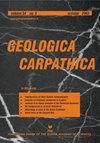东北波西米亚地块Silesicum石英矿化指示的区域低温流体流动
IF 1.5
4区 地球科学
Q4 GEOSCIENCES, MULTIDISCIPLINARY
引用次数: 0
摘要
波西米亚地块西里西亚单元的结晶岩中含有两种主要类型的热液石英脉。与花岗岩体伴生的矿脉主要为石英、硅灰石和绿帘石,伴寄主岩热液蚀变,也有较为复杂的“高山型”矿脉。石英晶体内的L + V + S(液体+蒸汽+固相)流体包裹体含有白云母和±方解石(±赤铁矿)作为固相,均质温度在124至176℃之间。捕获流体均为H2O-NaCl-CaCl2±MgCl2±KCl体系,矿化度在9.1 ~ 26.8质量% (NaCl + CaCl2)之间。不同的Na/Ca比值是由不同强度的流体-岩石反应引起的。无处不在的白云母是流体-岩石相互作用的产物。氧同位素证据表明,这些流体是深层区域尺度对流系统中大气和海水的混合物。所研究的流体类型代表了后瓦里斯坎热液系统,并显示了波希米亚地块东北边缘上地壳的迁移路径程度。本文章由计算机程序翻译,如有差异,请以英文原文为准。
Regional low-temperature fluid flow indicated by quartz mineralization in Silesicum, NE Bohemian massif
The crystalline rocks of the Silesicum unit of the Bohemian Massif host two principal types of hydrothermal quartz veins. Veins associated with granitoids are primarily quartz with wollastonite and epidote and accompanied by hydrothermal alteration of host rocks whereas others are of the more complex “Alpine-type”. L + V + S (liquid + vapour + solid phase) fluid inclusions within quartz crystals contain muscovite and ± calcite (± haematite) as solid phases and homogenisation temperatures are between 124 and 176 °C. Trapped fluids are uniformly of the H2O–NaCl–CaCl2 ± MgCl2 ± KCl system with a salinity between 9.1 and 26.8 mass % (NaCl + CaCl2). The variable Na/Ca ratios result from different intensity of fluid-rock reactions. The ubiquitous muscovite is a product of fluid-rock interactions. Oxygen isotope evidence indicates that the fluids were a mixture of meteoric and marine waters in deep regional-scale convection systems. The studied type of fluids represents a post-Variscan hydrothermal system and shows the extent of migration pathways in the upper crust on the north-eastern edge of the Bohemian Massif.
求助全文
通过发布文献求助,成功后即可免费获取论文全文。
去求助
来源期刊

Geologica Carpathica
地学-地球科学综合
CiteScore
2.40
自引率
23.10%
发文量
26
审稿时长
>12 weeks
期刊介绍:
GEOLOGICA CARPATHICA covers a wide spectrum of geological disciplines including geodynamics, tectonics and structural geology, volcanology, stratigraphy, geochronology and isotopic geology, karstology, geochemistry, mineralogy, petrology, lithology and sedimentology, paleogeography, paleoecology, paleobiology and paleontology, paleomagnetism, magnetostratigraphy and other branches of applied geophysics, economic and environmental geology, experimental and theoretical geoscientific studies. Geologica Carpathica , with its 60 year old tradition, presents high-quality research papers devoted to all aspects not only of the Alpine-Carpathian-Balkanian geoscience but also with adjacent regions originated from the Mediterranean Tethys and its continental foreland. Geologica Carpathica is an Official Journal of the Carpathian-Balkan Geological Association.
 求助内容:
求助内容: 应助结果提醒方式:
应助结果提醒方式:


